I Found These Two Quick Tests That Are Supposed To Estimate How Many Characters You Know:
i found these two quick tests that are supposed to estimate how many characters you know:
test one
test two
as the explanation for the second test explains, you should only click on a character if you know both the pronunciation and definition since it’s fairly easy to guess a character’s pronunciation. you can take both tests in simplified or traditional
according to these tests, i know somewhere between 2,800 and 2,900 characters! what about you?
(if you study japanese you can give these tests a try too just for fun!)
More Posts from Lia-kotik-blog and Others
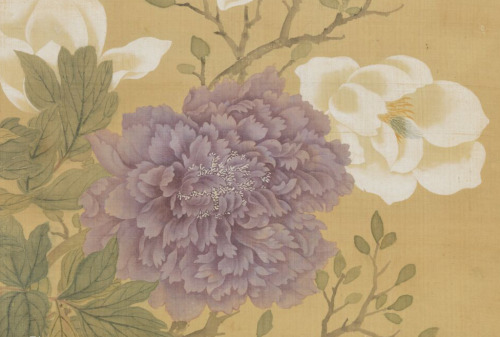
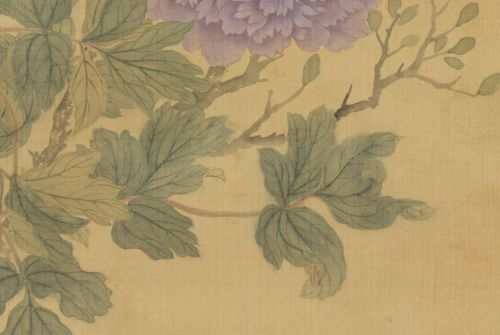

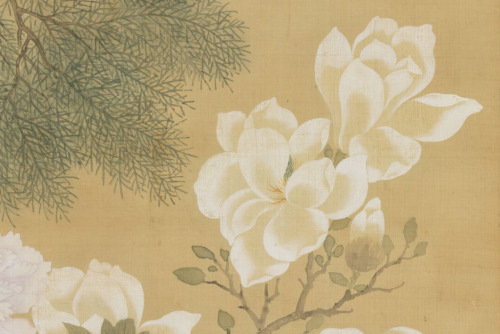
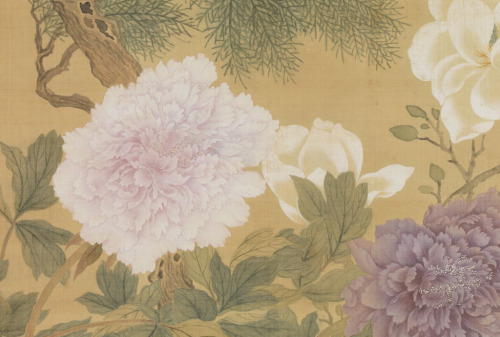
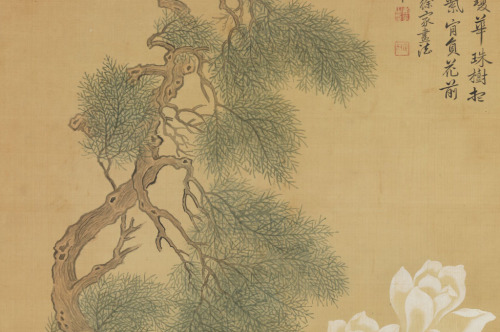
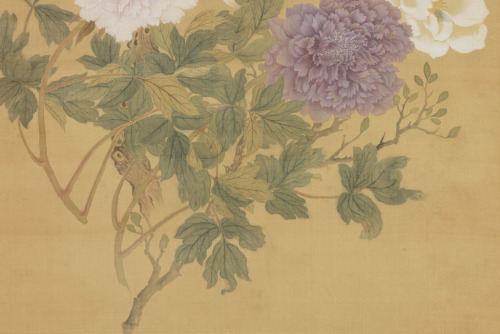
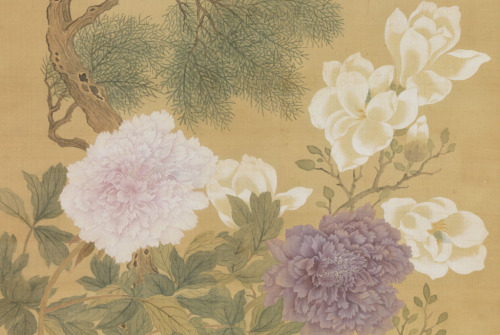

chinese artist 恽寿平 yun shouping (1633-1690)
A man in Inner Mongolia, China, comparing the sizes of goats at different ages.
English added by me :)





上海外灘 Shanghai bund
shén shòu神兽, mythological animals in chinese culture for references and inspiration part Ⅰ: nine offsprings of loong🐲🐉
In addition to the well-known Loong🐉 (dragon but not western dragon)and the Fenghuang(Phoenix), there are countless other divine beasts(or beasts of spiritualization) in Chinese mythology, their system is huge and complex, from various ancient texts and folklore, such as “Loong gives birth to nine offsprings 龙生九子”, meaning the nine descendants of Loong and they are born from the mating of Loong and other divine beasts, with different forms, and their images can often be seen in Chinese folk culture.

1. 囚牛[qiú niú]
Qiuniu, the eldest offspring of the dragon, is said to have loved music all his life. Legend has it that qiuniu was the most docile of all the dragon’s sons, and that it was not a killer or a fighter, but rather a musician. It had a head like a dragon and a body like a snake, and its hearing was so good that it could distinguish the sounds and the pitch of everything. It often crouches on ancient Chinese stringed instruments to enjoy the music of the plucked strings, which is why its statue was carved on them. ↓



2. 睚眦[yá zì]
Yazi, the second offspring, has the head of a dragon and the body of a jackal, is fierce, courageous, bloodthirsty and murderous, and always has a sword in its mouth and a furious stare, often engraved on the handle of a sword as a symbol of guardianship and strength. The original meaning of yazi is to stare in anger, a symbol of blood and vengeance, and so yazi became the embodiment of the destruction of all evil. ↓



3. 嘲风[cháo fēng]
Chaofeng is the third in line and enjoys adventure and views from high places.
In Chinese folklore, chaofeng symbolises good fortune, beauty and majesty, and also serves to deter demons, remove calamities and ward off evil spirits. It adds a layer of mystery to a towering hall and can act as a deterrent to evil and avoid disaster. ↓
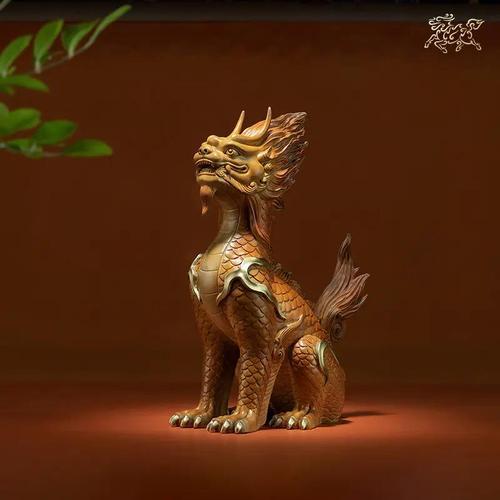

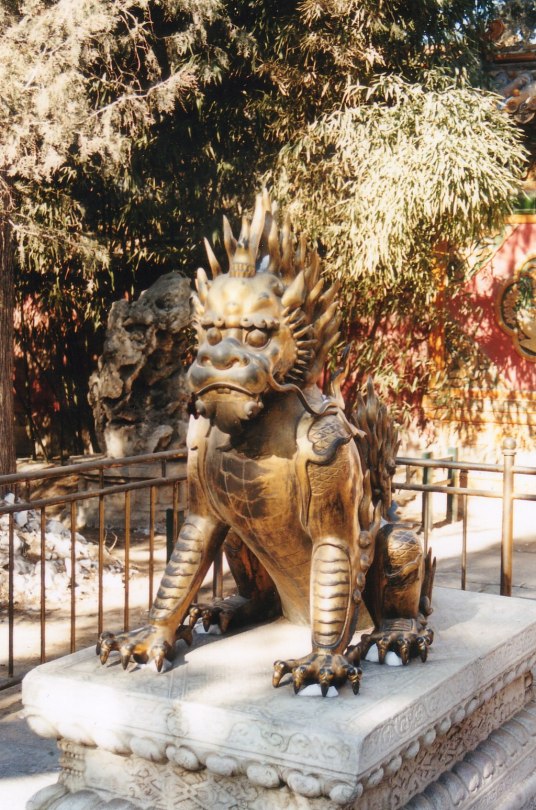

4. 蒲牢[pú láo]
Pulao loves sound and a good roar, and is often carved on the great bells of Chinese temples. Legend has it that the pulao lived by the sea and was terrified of whales. When the whale attacked, he was so frightened that he roared loudly. In response to its ‘fondness for roaring’, the pulao was cast on the bell of the temple and the wooden pestle used to strike the bell was carved in the shape of the whale. When the bell is struck, the whale strikes the pulao one after the other, so that the sound of the bell can be heard from very far. ↓

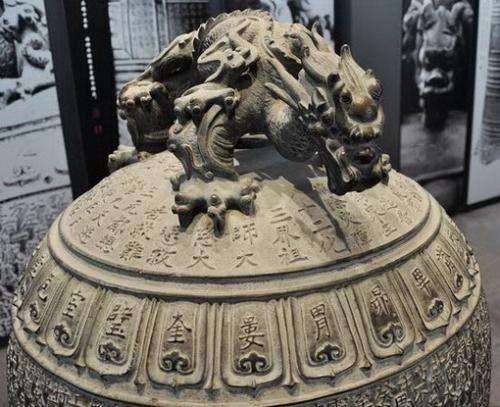


5. 狻猊 [suān ní]
Resembling a lion, suanni is a quiet and immobile creature that sits well and loves fireworks, and is often used to decorate the foot of incense burners.
There are three broad uses for the suanni. One is as a mount for a Buddha or Bodhisattva, a guardian animal. Legend has it that the suanni liked to sit quiet for long time, so when the Buddha saw that it had patience, he took it as a mount. Secondly, the suanni was regarded as a auspicious beast to ward off evil and was introduced into people’s practical lives, and was gradually used extensively in architectural decoration, folklore festivals and bronze mirror decoration. Thirdly, it was used to ward off evil spirits, to guard tombs, and to guard palace gates and mansions. In view of the supreme power of the Buddhist kung fu ‘lion’s roar’, suanni stone sculptures were used in the Sui and Tang dynasties to guard tombs to ward off evil spirits or to symbolise authority. ↓

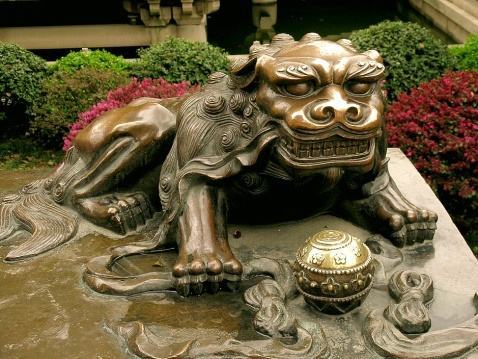


6. 赑屃[bì xì] Bixi is one of the nine sons of the dragon in ancient Han mythology, also known as baxia霸下 and ranked sixth. It has a tortoise-like appearance and likes to carry heavy loads on its back, often carrying stone monuments for years. Bixi is often used as a base for stone monuments, and is of great cultural importance. Its symbolism is based on 'longevity and good fortune’ and has connotations of status, totem worship and witchcraft. ↓


7. 狴犴bì àn, also known as Charter, is loong’s seventh offspring. It looks like a tiger, very powerful, and enjoy living a litigious life. The tiger head decoration on the prison door is Bian.
Ancient scripture《龙经》notes: “Bian likes to argue, and it has a name called charter.” It is said that Bian is not only loyal to justice, but also able to distinguish right from wrong and judge justly. In addition to its majestic appearance, bian is not only decorated on the prison door, but also lying on both sides of the ancient government hall. Whenever the magistrate sits in the hall, Bian’s image is on the top of the title board and the silence board. Bian looks around fiercely to maintain the solemn integrity of the court.
Bian is both the symbol of prison and the patron saint of ordinary people. In 上虞区上浦镇冯浦村, shaoxing, zhejiang province, there are the cultural custom of 'Bian Loong dance狴犴龙舞’, which had local characteristics and are deeply welcomed by the local people. ↓


8. 负屃[fù xì ]
The fuxi is the eighth offspring born to the dragon in ancient Chinese mythology. Its body resembles that of a dragon and it has a gentle disposition, preferring to coil around the head of a stone monument. It is a lover of literature and calligraphy and likes to coil around the tops of stone monuments with beautiful inscriptions. It is usually seen together with the bixi, which carries the monument, and the fuxi coils around the top of the monument. ↓


9. 螭吻 or 鸱吻 [chī wěn]
It is generally considered to be the ninth offspring of the dragon. It likes to swallow things and is said to be able to devour everything, as seen on the head of the beast on the roof of a Chinese palace. Chiwen likes to look around and is carved to look like it is swallowing the roof with its mouth open, and often has a sword stuck in its back. Legend has it that chiwen can spout waves and send down heavy rain, ward off fires and drive away spirits and demons. So Chinese folk asked it to watch over the horizontal ridges of houses. It likes to climb high and look down, so it is regarded as an ornament in folklore to pray for rain and to ward off fire. Chiwen is the child of a dragon and a fish, so its head is a dragon’s head but its body is in the shape of a fish. ↓



summary and some related patterns↓






沉鱼落雁,闭月羞花
Literal Translation: to make fish sink and wild geese drop, to outshine the moon and shame the flowers
Individual Characters:
沉 (chén) : to sink
鱼 (yú) : fish
落 (luò) : to fall/descend (降落)
雁 (yàn) : wild goose (大雁)
闭 (bì) : to shut/close; to obstruct (note: this word appears in lots of two-character words having to do with shutting/closing, but I can't find a word it's in that means "outshine" like it does in this phrase, unless one of you knows of one, it's most likely a purely metaphorical meaning)
月 (yuè) : moon
羞 (xiū) : to shame
花 (huā) : flower
Story:
This one has to do with the Four Beauties (四大美人) of China. If you don't know their stories, I'd recommend looking into them; I'm not going to rehash them here because I don't know them very well myself, but I'll give a brief summary (keep in mind these will be very surface level and there's much much more to the stories)
西施 (xī shī) lived during 春秋, the Spring and Autumn Period (770-476 BCE) and is the first of the 四大美人。 She went to the river one day to wash clothes, and, seeing her through the water, the fish were so stunned by her beauty that they forgot to swim and sank to the bottom of the river. Her story makes up the 沉鱼 portion of this 成语。
王昭君 (wáng zhāo jūn) lived during 西汉, the Western Han Dynasty (206 BCE-25 CE). During this time period, the Xiongnu and the Han kept having border skirmishes, so the emperor decided to send 王昭君 to marry the leader of the Xiongnu. On her way, she played her lute. The geese heard the music and looked down, forgetting to fly after seeing her beauty. Her story makes up the 落雁 portion.
貂蝉 (diāo chán) lived during 东汉, the Eastern Han Dynasty (25 - 220 CE). It's said that when she went out at night, clouds would immediately cover the moon. Because of this, it was said that she outshone the moon. Her story makes up the 闭月 portion.
杨玉环(yáng yù 杨宇huanhuán) lived during 唐朝, the Tang Dynasty (618 - 907 CE). She was selected to be a concubine because of her beauty, but she missed home. One day, while walking in the palace gardens, she touched a flower. It folded in on itself, and, a palace maid having seen, the legend that 杨玉环 shamed the flowers with her beauty was born. Her story makes up the 羞花 portion.
Figurative Meaning:
沉鱼落雁:to be incredibly beautiful/captivating
闭月羞花:to be unnaturally/exceedingly beautiful
沉鱼落雁 and 闭月羞花 can be used together or separately
Resources/Further Reading:
Road to Learning Chinese Podcast (A)
Road to Learning Chinese Podcast (B)
Chinese Tuition Singapore (all Chinese story)
Yang Chen Live Journal
Confucius Classroom (video for learners)
老梁 (video completely in chinese and designed for natives i think?)

Some chinese resources (found in this article: https://kaohongshu.blog/2019/12/03/should-i-read-chinese-texts-above-my-level/
Where do I find suitable online reading resources?
Free online resources:
My Chinese Reading (all levels) *I’ve used this it’s great, especially as graded reading material that gradually increases in difficulty in a manageable way
Mandarin Bean (all levels)
HSK reading (all levels) *Just looked, seems good for finding graded reading material specific to HSK level
Chinese Reading Practice (all levels) *I’ve used this, also great for graded reading material that manageably increases in difficulty
Just learn Chinese (all levels)
The Marco Polo Project (advanced)
Mandarin version of the New York Times (advanced)
BBC news in Mandarin Chinese (advanced)
Chinese news from Deutsche Welle (advanced)
Project Gutenberg in Chinese (highly advanced)
An Annotated Collection of Digitized Chinese Texts for Students of Chinese Language and Culture (highly advanced) *I’m looking at this right now and a ton of useful material
Tips for Writing Sentences in a Foreign Language - for Beginners
Having studied 3 foreign languages at varying degrees of intensity and success - Japanese (I flatter myself to be fluent), Spanish (I can ask some simple questions and possibly crudely insult someone), French (I can say a few well-sounding phrases and then smile & nod when you respond). When beginning studies in languages, one of the most challenging things is to jump from the set beginner phrases from the textbook into creating your own sentences (gasp).
From my own language studies, plus experience TA'ing first year Japanese, I have a few tips for beginners on taking that leap into creating your own sentences. These will probably lean heavily on Japanese because that is the language I have the most experience with, but they are applicable to other languages too.

1. Just start making sentences!
It sounds simple, but it's the best way to start. Writer's block? Write about what you are doing, what you want to do, or write an introduction. Worried about speaking? Talk to yourself about what you are doing, what you want to do, or introduce yourself to yourself. You don't have to write or say anything world-shaking, but getting started is the first step. You can start by modeling sentences you've already seen. If you have an example textbook sentence, try modifying it to make your own similar sentence.
PS. Your sentences don't have to be perfect either. If you notice a mistake later, just go back and correct yourself!
2. Don't try to translate the phrase from your native language EXACTLY into your target language.
Languages don't always translate exactly, but also, sometimes your skill isn't advanced enough to say the same things you can say in your native language. If you don't yet know the appropriate grammar, vocabulary, or syntax of what you want to say, not being able to say exactly what you want can be frustrating and lead you to feel defeated (personal experience here). Instead, think of how to put the idea you have into a sentence using the knowledge you DO have.
If you have just started learning a language, it might be too much to directly translate "Entities should not be multiplied unnecessarily" (thanks, Ockham's Razor). Instead, why not try to translate "Simple is best"?
3. Avoid heading straight for the dictionary if possible when there is a word you don't know in your target language.
If you don't have the vocabulary word you need in a sentence, you might be tempted to go to the dictionary and look it up and throw it into your sentence. Whilst TA'ing first-year Japanese, this led to me puzzling and scratching my head over what the student was trying to say in their homework (hey, it's not my first language either!).
While using the dictionary to learn new vocabulary is obviously a must, when you are just starting out with sentence building it can also be a roadblock. When conjugating verbs is new to you, try using the verbs you do know to explain your idea. If you don't know a vocabulary word, selecting the right one for your context from a list of words with similar definitions can be difficult. If you don't quite know how to explain what you want to say, try rephrasing it until you can compose a less complicated sentence. Or break it into several sentences - you can work on complicated sentences when you're more comfortable with simpler ones!
Another bonus is that learning to explain what you want to say in your target language when you don't know the vocabulary is a helpful lifelong skill (that I still use today in Japanese). It can be frustrating to not be able to say exactly what you want to say in your target language at first, but if you just keep practicing you will get there.
4. Practice making sentences on the fly.
Writing allows you more time to think out the sentence, go back and make changes, and work things out more slowly. Speaking, on the other hand, is more challenging because you have to make your mouth form the words you are thinking, and do your best to make the sentence make sense to your listener. While writing sentences helps me to remember how to write hiragana/katakana/kanji and reinforces grammar (I learn best by writing it out!), speaking out loud helps your brain and your mouth learn to work together in your target language.
Don't have anyone to talk to? That's ok! Talk to yourself. Talk to your imaginary friends. Talk to your pet or your houseplant or your favorite figurine or stuffed animal. Just practice putting sentences together out loud, in real time. I promise you will notice improvement if you practice daily!
5. Don't be afraid of making mistakes!
But even if you do just throw in the dictionary word and your professor/study buddy/language exchange partner has to ask you what you were trying to say, that's ok! Making mistakes is ok! That's how you learn. Don't be afraid to be wrong, to be mocked and ridiculed.. ok, you most likely won't be mocked and ridiculed. (If you are, please find new language friends.)
Language learning is about making mistakes. Even now, after YEARS of studying and speaking and even doing interpretation/translation... I make mistakes (gasp). And it's ok. Ok, sometimes I think about the mistakes I have made in conversation in the middle of the night, but I'm working on that too. One day, you'll look back, and realize that agonizing over particles and which kanji to use and whether or not you would sound dumb when you were speaking to a native speaker is not the part you remember. You will remember when you could barely write your name in katakana, and realize that suddenly you can talk about your favorite hobby in exacting detail.
6. Don't practice in a vacuum.
Practicing sentences, written or spoken, on your own is fine! It's a great way to learn and improve your language skills. But I would recommend not spending all your time studying and practicing in a vacuum. There are lots of online ways to get your writing or speaking corrected (paid or not), and I would recommend taking advantage of them. I have gotten into the habit of using certain words that are too informal or that are not correct in the context I wanted to use them in, and it took a native speaker to point them out since I had become so used to using them (and so sure that I was right). So make sure to practice your language outside of your own head, and you will be able to improve even more.
So, what next?
Get out there and start making sentences! Write them, say them, and just practice. Don't stress about being perfect or making sentences that will change the course of history... instead, just start making sentences!
頑張ってね!
Update: New resources added!!
Over the past 2 days I've added new resources to my resources page! They're instagram/social media tutors but I've complied a mini list here. Some I like more than others, but I would recommend all of them to supplement your studies! Full reviews are on the page~
I also updated a few ratings and pricing for some of the resources as well, which I've made note of in the descriptions on the page.
Here are the new ones I added!
Zita Wong Chinese - insta, adorable and kind and progressive, great functional and colloquial vocab, real-life conversations and interviews with native and nonnative speakers in China
Leila Laoshi - non-native speaker who has translated chinese professionally, great vocab, fascinating lifestyle living in bali
Chilling Chinese - awesome podcasts, actually affordable membership
Sabine Hui Chinese - funny, functional & colloquial vocab
Learn Chinese with Jian - pronunciation guides & functional vocab






Whisper of the Heart 耳をすませば 1995 | dir. Yoshifumi Kondō
-
 scamanderpotter liked this · 1 year ago
scamanderpotter liked this · 1 year ago -
 hanekco liked this · 1 year ago
hanekco liked this · 1 year ago -
 ah-zuki liked this · 1 year ago
ah-zuki liked this · 1 year ago -
 wraiths-and-candles reblogged this · 1 year ago
wraiths-and-candles reblogged this · 1 year ago -
 millionponds liked this · 2 years ago
millionponds liked this · 2 years ago -
 5bloodyroses liked this · 2 years ago
5bloodyroses liked this · 2 years ago -
 i-will-learn-another-language reblogged this · 2 years ago
i-will-learn-another-language reblogged this · 2 years ago -
 headlights-at-night reblogged this · 2 years ago
headlights-at-night reblogged this · 2 years ago -
 ya3lan2 liked this · 2 years ago
ya3lan2 liked this · 2 years ago -
 awesomenoodles liked this · 2 years ago
awesomenoodles liked this · 2 years ago -
 thejoyoflearninglanguages liked this · 2 years ago
thejoyoflearninglanguages liked this · 2 years ago -
 bookeeperofdreams reblogged this · 2 years ago
bookeeperofdreams reblogged this · 2 years ago -
 bookeeperofdreams liked this · 2 years ago
bookeeperofdreams liked this · 2 years ago -
 shuheather liked this · 2 years ago
shuheather liked this · 2 years ago -
 atomic-moose liked this · 2 years ago
atomic-moose liked this · 2 years ago -
 vulturecadens liked this · 2 years ago
vulturecadens liked this · 2 years ago -
 tensorate liked this · 2 years ago
tensorate liked this · 2 years ago -
 liu-anhuaming reblogged this · 2 years ago
liu-anhuaming reblogged this · 2 years ago -
 ayin-me-yesh reblogged this · 2 years ago
ayin-me-yesh reblogged this · 2 years ago -
 ayin-me-yesh liked this · 2 years ago
ayin-me-yesh liked this · 2 years ago -
 yinnixuexi reblogged this · 2 years ago
yinnixuexi reblogged this · 2 years ago -
 yu-dreams reblogged this · 2 years ago
yu-dreams reblogged this · 2 years ago -
 sourjellies liked this · 2 years ago
sourjellies liked this · 2 years ago -
 bees99 liked this · 2 years ago
bees99 liked this · 2 years ago -
 lia-kotik-blog reblogged this · 3 years ago
lia-kotik-blog reblogged this · 3 years ago -
 lia-kotik-blog liked this · 3 years ago
lia-kotik-blog liked this · 3 years ago -
 catonthesun liked this · 3 years ago
catonthesun liked this · 3 years ago -
 dashynke liked this · 3 years ago
dashynke liked this · 3 years ago -
 don-dake liked this · 3 years ago
don-dake liked this · 3 years ago -
 robin-cyann liked this · 3 years ago
robin-cyann liked this · 3 years ago -
 brausol liked this · 3 years ago
brausol liked this · 3 years ago -
 academic-panda reblogged this · 3 years ago
academic-panda reblogged this · 3 years ago -
 christinamarieee liked this · 3 years ago
christinamarieee liked this · 3 years ago -
 lanwario liked this · 3 years ago
lanwario liked this · 3 years ago -
 parketmansion liked this · 3 years ago
parketmansion liked this · 3 years ago -
 huyetao liked this · 3 years ago
huyetao liked this · 3 years ago -
 yourmolerat liked this · 3 years ago
yourmolerat liked this · 3 years ago -
 mandarinacatarina reblogged this · 3 years ago
mandarinacatarina reblogged this · 3 years ago -
 wanderingkloud reblogged this · 3 years ago
wanderingkloud reblogged this · 3 years ago -
 wanderingkloud liked this · 3 years ago
wanderingkloud liked this · 3 years ago -
 lisbeibeth liked this · 3 years ago
lisbeibeth liked this · 3 years ago -
 willbilldillpickle liked this · 3 years ago
willbilldillpickle liked this · 3 years ago -
 kaoru---stuff liked this · 3 years ago
kaoru---stuff liked this · 3 years ago -
 killericecream liked this · 3 years ago
killericecream liked this · 3 years ago -
 studyinglogic liked this · 3 years ago
studyinglogic liked this · 3 years ago